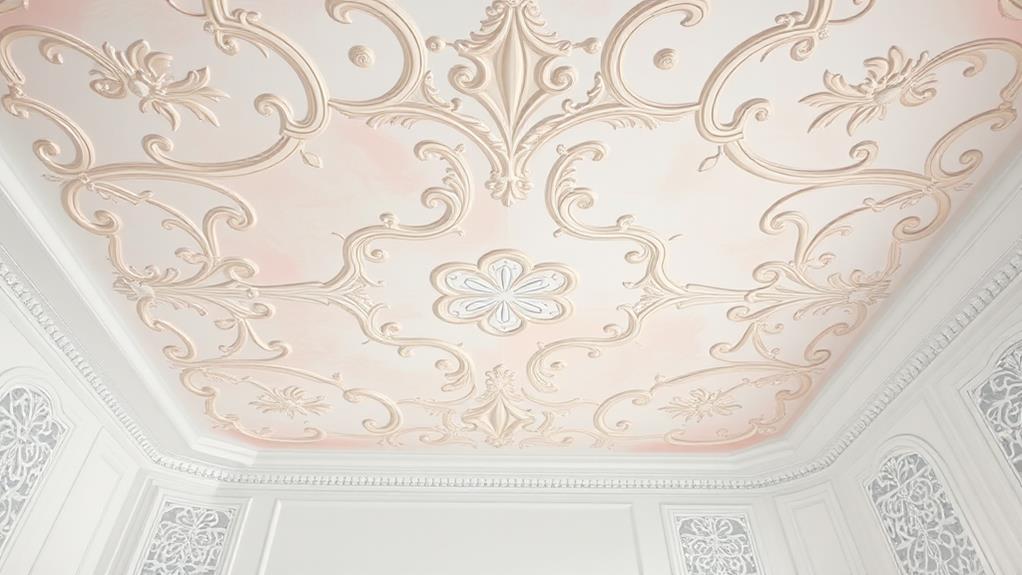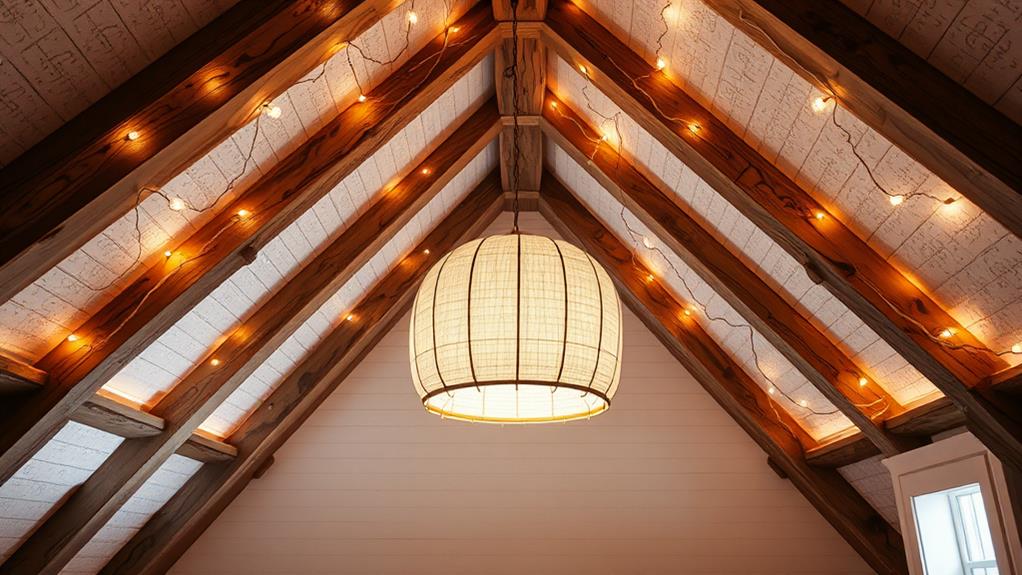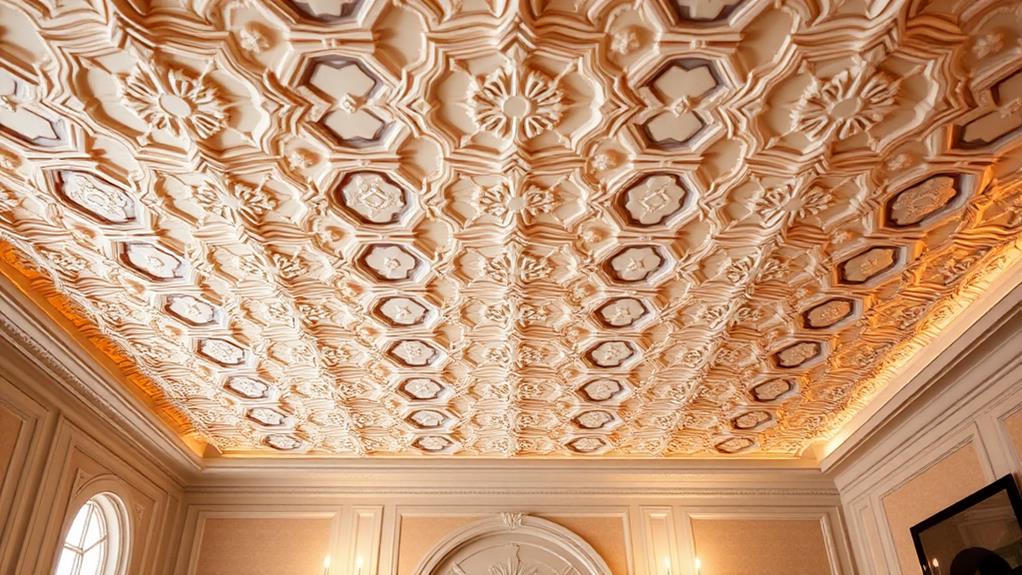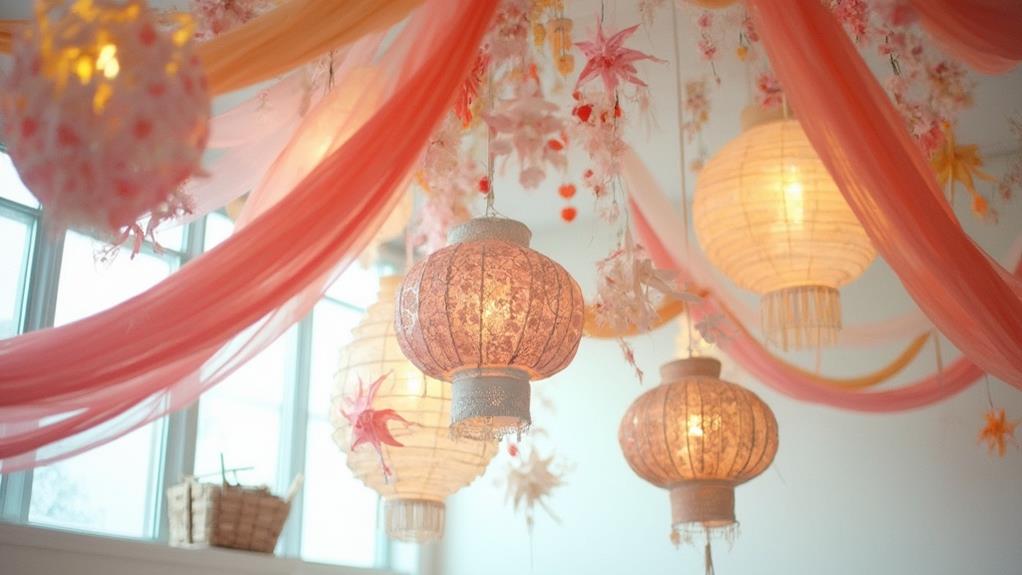Transform your ceiling into a stunning focal point without breaking the bank. Paint techniques like color washing and stenciling offer visual impact, while budget-friendly architectural elements such as faux beams and ceiling medallions add depth. Clever lighting solutions, including LED strips and unique pendant lights, create ambiance and interest. Textured treatments, decorative tiles, and natural materials provide diverse options for enhancing overhead spaces. From DIY projects to affordable prefabricated solutions, there are numerous ways to elevate your ceiling's appeal. Explore these creative ideas to discover how you can turn a plain ceiling into a captivating design element in your home.
Paint Techniques for Visual Impact

Color is a powerful tool for transforming overhead spaces. By utilizing various paint techniques, homeowners can create visually striking ceilings without breaking the bank. One popular method is color washing, which involves applying a translucent glaze over a base coat to produce a soft, textured appearance. This technique adds depth and dimension to flat surfaces, creating an illusion of movement.
Another effective approach is stenciling, which allows for intricate patterns and designs to be painted onto the ceiling. Geometric shapes, floral motifs, or even faux tin tile patterns can be achieved with carefully chosen stencils and complementary paint colors. For a more dramatic effect, consider creating a faux finish such as marble or wood grain using specialized painting tools and techniques.
Striping is another cost-effective way to add visual interest overhead. Whether opting for bold contrasting colors or subtle tone-on-tone variations, stripes can make a room appear larger or cozier depending on their orientation and width. Finally, consider an ombré effect, gradually blending one color into another across the ceiling's expanse, creating a soft, ethereal atmosphere that draws the eye upward.
Architectural Elements on a Budget
Adding architectural elements to a ceiling can dramatically enhance a room's visual appeal without requiring a substantial investment. Faux beams made from lightweight polyurethane or foam offer an affordable alternative to real wood, providing the illusion of exposed structural elements. These can be easily installed with adhesive and painted to match any decor.
Ceiling medallions, once reserved for chandeliers in grand spaces, are now available in various sizes and styles at budget-friendly prices. These decorative elements can be used to accentuate light fixtures or stand alone as focal points. For a more modern touch, consider installing floating panels or coffered ceiling kits, which create depth and interest without the need for extensive construction.
Crown molding is another cost-effective way to add architectural detail where the walls meet the ceiling. DIY-friendly foam or polyurethane moldings are lightweight and easy to install. For a unique twist, try installing molding in geometric patterns on the ceiling itself. Lastly, pressed tin ceiling tiles or their plastic lookalikes can provide a vintage feel or contemporary texture, depending on the chosen design and finish.
Clever Lighting Solutions

Beyond the realm of architectural elements, clever lighting solutions can transform a ceiling's appearance and ambiance without breaking the bank. One cost-effective approach is to install LED strip lights along the perimeter of the room or in recessed areas, creating a soft, indirect glow that adds depth and warmth.
Another option is to use pendant lights with unique shades or designs, which serve as both functional lighting and decorative focal points.
For a more dramatic effect, consider installing a dimmer switch to control overhead lights, allowing for adjustable mood lighting. String lights or fairy lights can be artfully draped across the ceiling to create a whimsical or cozy atmosphere, particularly effective in bedrooms or entertainment spaces. Wall sconces that direct light upward can also highlight ceiling textures and create interesting shadow patterns.
Repurposing everyday objects as light fixtures, such as mason jars or industrial piping, can add character while keeping costs low. Finally, strategically placed mirrors or reflective surfaces on the ceiling can amplify existing light sources, making the room appear brighter and more spacious without additional electrical work.
Textured Ceiling Treatments
While lighting can dramatically alter a room's atmosphere, textured ceiling treatments offer a tactile and visual dimension that transforms the entire space. These treatments range from subtle to bold, providing an array of options to suit various tastes and interior styles.
One cost-effective approach is applying textured paint using specialized rollers or brushes. This technique creates patterns like swirls, stipples, or knockdown textures, adding depth and interest to plain ceilings. Another affordable option is installing foam or polystyrene ceiling tiles, which come in diverse designs and can be easily adhered to existing surfaces.
For a more rustic appeal, consider faux wood beams made from lightweight polyurethane. These replicate the look of exposed wooden beams without the structural complications or expense. Alternatively, embossed wallpaper designed for ceilings offers intricate patterns and can be painted to match your decor.
Textured spray treatments, applied by professionals or adventurous DIYers, create a consistent, fine-grain texture across the ceiling. This method effectively hides minor imperfections and adds a soft, uniform look to the overhead plane.
Decorative Tiles and Patterns

Decorative tiles and patterns offer a striking way to elevate the visual appeal of ceilings without breaking the bank. These versatile design elements come in various materials, including lightweight foam, tin, and plastic, making them easy to install and affordable for most homeowners. Adhesive-backed options simplify the application process, allowing for quick DIY installation without the need for professional help.
Ceiling tiles are available in an array of styles, from classic tin-look designs to modern geometric patterns. Homeowners can create visual interest by alternating tile designs or arranging them in unique configurations. For a more subtle effect, consider using paintable tiles that can be customized to match or complement the room's color scheme.
Patterned ceiling designs can also be achieved through stenciling or wallpaper application. Stencils offer a cost-effective way to add intricate designs to ceilings, while peel-and-stick wallpaper provides a temporary solution for renters or those who enjoy frequently updating their decor. When selecting patterns, consider the room's size and existing design elements to ensure a cohesive look that enhances the overall aesthetic without overwhelming the space.
Natural Materials and Finishes
Incorporating natural materials and finishes into ceiling designs can create a warm, organic atmosphere while remaining budget-friendly. Wood is a versatile option, offering various textures and tones. Reclaimed wood planks can be installed as a rustic accent or cover the entire ceiling for a cozy cabin feel. Bamboo panels provide a sustainable alternative with a unique, linear appearance.
For a more textured look, consider applying cork tiles or sheets. Cork is not only eco-friendly but also offers excellent acoustic properties, making it ideal for noise reduction. Grass cloth, typically used for wall coverings, can be adapted for ceilings to add subtle texture and natural color variations.
Natural stone veneers, while slightly more expensive, can create a stunning focal point when applied to a small section of the ceiling. Alternatively, faux stone panels made from lightweight materials offer a similar aesthetic at a lower cost. For a softer touch, jute or sisal rope can be woven into intricate patterns or applied in a linear design. These natural materials not only enhance visual interest but also contribute to a healthier indoor environment by improving air quality and reducing synthetic materials in the space.
Frequently Asked Questions
How Long Does a Ceiling Renovation Typically Take?
The duration of a ceiling renovation typically varies depending on the project's scope and complexity. Simple updates may take 1-3 days, while more extensive renovations could span 1-2 weeks. Factors like room size and chosen materials also influence timelines.
Can I Install a New Ceiling Treatment Over Popcorn Ceilings?
Installing new ceiling treatments over popcorn ceilings is possible, but not recommended. It's best to remove the popcorn texture first for better adhesion and a smoother result. Professional removal ensures proper preparation for the new treatment.
What Tools Are Necessary for DIY Ceiling Projects?
Essential tools for DIY ceiling projects include a ladder, safety goggles, dust mask, utility knife, putty knife, tape measure, level, drywall saw, sanding block, paintbrushes, rollers, and a drill. Specific tools may vary depending on the project's requirements.
Are There Soundproofing Options That Also Enhance Ceiling Aesthetics?
Yes, several soundproofing options can enhance ceiling aesthetics. Acoustic panels, decorative foam tiles, and fabric-wrapped fiberglass boards offer both noise reduction and visual appeal. Textured ceiling treatments and suspended cloud panels can also serve dual purposes of soundproofing and design.
How Do I Choose the Right Ceiling Treatment for My Room's Size?
Did you know that ceiling height can affect perceived room size by up to 25%? When choosing a ceiling treatment, consider your room's dimensions. For smaller spaces, opt for light colors and simple designs to create an illusion of height and openness.
Conclusion
Transforming ceilings from overlooked surfaces to captivating focal points requires creativity, not extravagance. Paint techniques dazzle, architectural elements add depth, and lighting solutions create ambiance. Textured treatments provide dimension, decorative tiles introduce patterns, and natural materials bring warmth. By exploring these inexpensive options, homeowners can elevate their spaces, quite literally, turning mundane ceilings into conversation pieces. With imagination and resourcefulness, the fifth wall becomes a canvas for personal expression and architectural interest, enhancing the overall aesthetic of any room.

